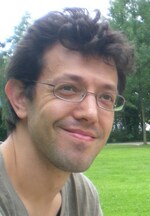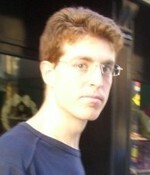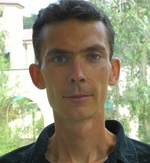About the Authors

Assaf Naor
Professor
Courant Institute of Mathematical Sciences, New York University, New York, NY
naor[ta]cims[td]nyu[td]edu
www.cims.nyu.edu/~naor/
Professor
Courant Institute of Mathematical Sciences, New York University, New York, NY
naor[ta]cims[td]nyu[td]edu
www.cims.nyu.edu/~naor/
Assaf Naor's research focuses on analysis and metric geometry, and their
interactions with approximation algorithms and complexity theory. He
received his Ph.D. from the Hebrew University in 2002, advised by Joram
Lindenstrauss. He is a Professor of Mathematics and Computer Science at the
Courant Institute of Mathematical Sciences of New York University, where he
has been a faculty member since 2006. Prior to joining the Courant Institute
he was a researcher at the Theory Group of Microsoft Research in Redmond WA.
Starting fall 2014 he will be a Professor of Mathematics at Princeton
University.

Oded Regev
Professor
Courant Institute of Mathematical Sciences, New York University, New York, NY
regev[ta]cims[td]nyu[td]edu
www.cims.nyu.edu/~regev/
Professor
Courant Institute of Mathematical Sciences, New York University, New York, NY
regev[ta]cims[td]nyu[td]edu
www.cims.nyu.edu/~regev/
Oded Regev graduated from
Tel Aviv University in 2001 under the
supervision of Yossi Azar.
He spent two years as a postdoc at the Institute for
Advanced Study, Princeton, and one year at the
University of California, Berkeley.
He recently joined the Courant Institute of Mathematical Sciences and is still trying to
get used to life in NYC. His research interests include computational
aspects of lattices, quantum computation, and other topics in theoretical computer
science.

Thomas Vidick
Assistant Professor
California Institute of Technology, Pasadena, CA
vidick[ta]cms[td]caltech[td]edu
cms.caltech.edu/~vidick
Assistant Professor
California Institute of Technology, Pasadena, CA
vidick[ta]cms[td]caltech[td]edu
cms.caltech.edu/~vidick
Thomas Vidick graduated from UC Berkeley in 2011; his advisor was Umesh Vazirani. His thesis focused on the study of quantum entanglement in multi-prover interactive proof systems and in quantum cryptography. After a postdoctoral scholarship at MIT under the supervision of Scott Aaronson, he moved back to sunny California. He is currently an assistant professor in Caltech's department of Computing and Mathematical Sciences, where his research is stimulated by the humbling mark left by
the previous occupants of his his office and his neighbors'
— Alexei Kitaev and Richard Feynman.
